Tips Cara Ganti Radiator Mobil
2.05.2011
0
komentar
Adsense Content. recommended 336 X 300
Tips Cara Ganti Radiator Mobil - Radiator kendaraan adalah komponen yang memindahkan panas dari mesin melalui pertukaran panas termal. Hal ini biasanya terletak di bagian depan kendaraan di bawah tenda. Mesin menciptakan panas dari pembakaran internal yang terus menerus terjadi di dalam mesin, panas ini akan dipindahkan ke pendingin mesin, kemudian beredar melalui thermostat kemudian ke radiator. Di dalam radiator terdapat tabung kecil dengan pendinginan sirip terpasang yang memungkinkan pendingin yang akan didinginkan dan kemudian kembali ke mesin di siklus berkelanjutan. Radiator sebagian besar terbuat dari 2 tangki plastik dan inti aluminium.
Langkah 1: Mengidentifikasi Sistem Pendingin Radiator dan Komponen (di bawah tenda)
Bagi pengunjung Blogg Di bawah ini belum saya terjemahkan silahkan anda terjemahkan sendiri dengan memilh bahasa sesuai bahasa anda di atas hearder blogg ada google translate.

Radiator Identification
The thermostat housing is where the thermostat resides; it is connected to the radiator upper tank. The system is filled and checked at the radiator cap. The radiator is held in place by the radiator holder brackets and is usually near the top radiator tank. Some radiator configurations may vary in appearance but the concept is the same.
Step 2: Disconnect Negative Battery Terminal
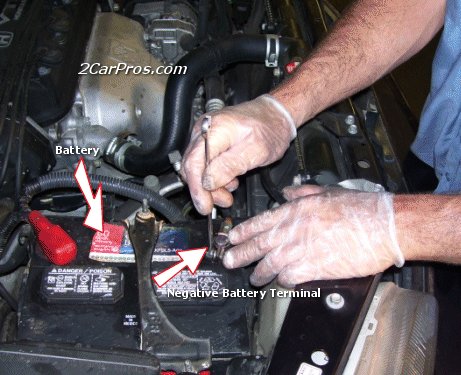
Remove Negative Battery Terminal
Make sure the ignition key is in the off position, loosen the terminal pinch bolt and disconnect the battery terminal (gloves suggested). Anytime you perform repair work like this it is a good idea to disconnect the battery to avoid electrical short circuits. Always disconnect the negative battery cable to avoid a short to ground and NEVER let the wrench contact to positive side of the battery. Make sure the battery is clean at all times. If corrosion exists rinse battery with water (hose) and sprinkle with baking soda to naturalize the remaining acid.
Step 3: Drain Cooling System

Locate Radiator Drain Plug
(Bottom View) Locate the radiator drain valve; turn it counter clockwise to loosen. On some cars there is a protective plastic splash guard that may need to be removed to access the radiator drain valve.
Step 4: Remove Lower Hose Connections and Drain Radiator
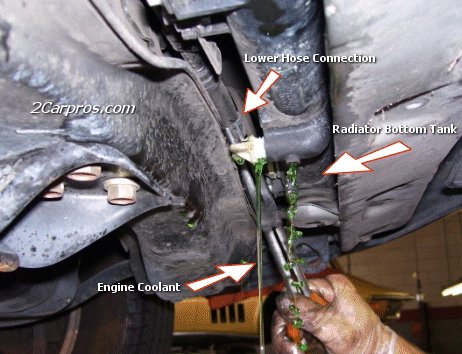
Drain Radiator and Remove Lower Hose Connections
(Bottom View) After the coolant has drained completely, locate lower hose connections to remove clamps and hoses. If your vehicle has lower radiator mounts or cooling fan mounts, remove those bolts also. NOTE: (The cooling fan bolts are optional. Sometimes it is easier to disconnect the wires to the fans and remove the cooling fans with the radiator.)
Step 5: Remove Upper Hose Connections

Remove Upper Radiator Hose Connections
Locate upper radiator hose to remove hose clamps and hose connection. Locate and remove upper cooling fan mounting bolts as required.
Step 6: Remove Upper Radiator Mount
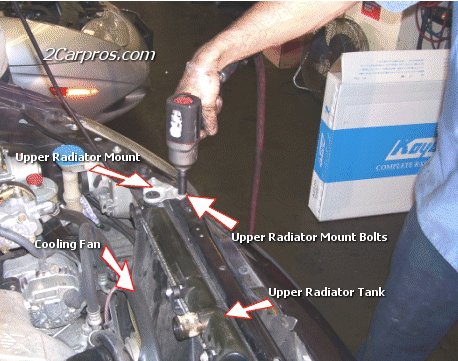
Locate and Remove Upper Radiator Mount Brakets
Locate upper radiator mounting brackets and remove the mounting bolts. If you have elected to remove the cooling fans with the radiator, locate the electrical connector and disconnect it as needed. If you are leaving the cooling fans behind when removing the radiator, remove the upper cooling fan mounting bolts. (Note in this photo an air impact gun is being used but a regular wrench will work just fine.)
Step 7: Remove and lift Radiator from Car
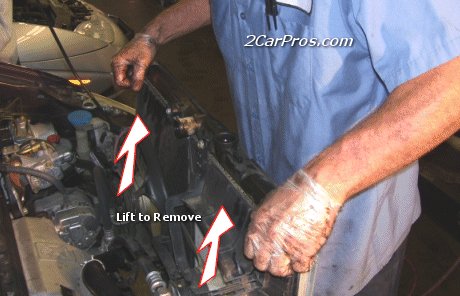
Lift Radiator From Car
After all previous steps have been completed; inspect the general area of the radiator making sure all other obstructions have been cleared. Next, lift radiator from vehicle removing the cooling fans if needed.
Step 8: Remove and Inspect Radiator
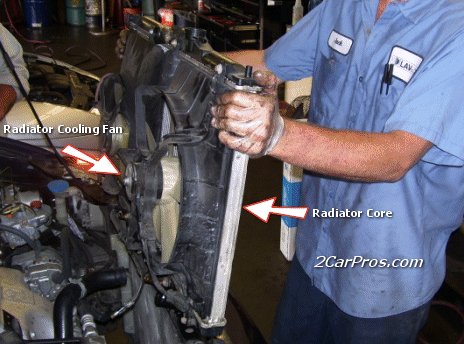
Inspect Old Radiator Once Removed
After removing the radiator from the vehicle, inspect the unit for mounting hole location and other key mounting brackets. Now you are ready to install the new radiator.
Step 9: Replacing the New Radiator
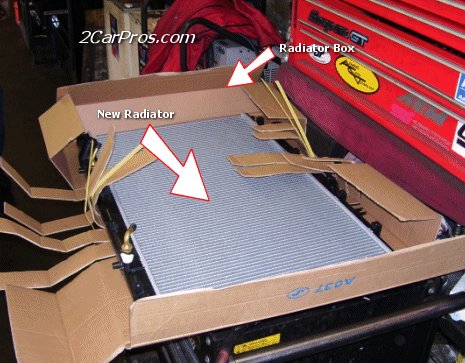
Inspect New Radiator and Match it to the Original Unit
Remove the radiator from the shipping carton and inspect it thoroughly for damage. Make sure all mounting holes are in the correct location and the overall size is correct.
Step 10: Installing Cooling Fans

Install Cooling Fans (if required)
Remove the cooling fans from the old radiator and install onto the new radiator. Make sure the cooling fan motor turns freely after the cooling fans have been installed. Clean electrical connector and make sure it is free from debris.
Step 11: Installing New Radiator
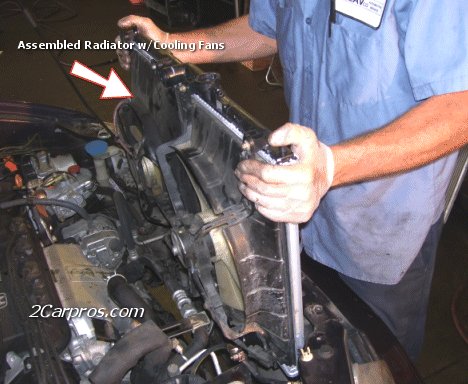
Install New Radiator Assembly
After the radiator is ready for installation, inspect the vehicle cavity that the radiator resides in to make sure all dirt and leaves have been removed. Reinstall radiator and reconnect all hoses, clamps and mounting bolts. After reinstallation is complete, refill the radiator with engine coolant or water. With the radiator cap off allow the engine to warm up. Top off the coolant level until at the full level. Reinstall the radiator cap and recheck the system for leaks. (Note: make sure the coolant reservoir is about half full with engine coolant, and recheck the coolant level when cold.)
Langkah 1: Mengidentifikasi Sistem Pendingin Radiator dan Komponen (di bawah tenda)
Bagi pengunjung Blogg Di bawah ini belum saya terjemahkan silahkan anda terjemahkan sendiri dengan memilh bahasa sesuai bahasa anda di atas hearder blogg ada google translate.

Radiator Identification
The thermostat housing is where the thermostat resides; it is connected to the radiator upper tank. The system is filled and checked at the radiator cap. The radiator is held in place by the radiator holder brackets and is usually near the top radiator tank. Some radiator configurations may vary in appearance but the concept is the same.
Step 2: Disconnect Negative Battery Terminal

Remove Negative Battery Terminal
Make sure the ignition key is in the off position, loosen the terminal pinch bolt and disconnect the battery terminal (gloves suggested). Anytime you perform repair work like this it is a good idea to disconnect the battery to avoid electrical short circuits. Always disconnect the negative battery cable to avoid a short to ground and NEVER let the wrench contact to positive side of the battery. Make sure the battery is clean at all times. If corrosion exists rinse battery with water (hose) and sprinkle with baking soda to naturalize the remaining acid.
Step 3: Drain Cooling System

Locate Radiator Drain Plug
(Bottom View) Locate the radiator drain valve; turn it counter clockwise to loosen. On some cars there is a protective plastic splash guard that may need to be removed to access the radiator drain valve.
Step 4: Remove Lower Hose Connections and Drain Radiator

Drain Radiator and Remove Lower Hose Connections
(Bottom View) After the coolant has drained completely, locate lower hose connections to remove clamps and hoses. If your vehicle has lower radiator mounts or cooling fan mounts, remove those bolts also. NOTE: (The cooling fan bolts are optional. Sometimes it is easier to disconnect the wires to the fans and remove the cooling fans with the radiator.)
Step 5: Remove Upper Hose Connections

Remove Upper Radiator Hose Connections
Locate upper radiator hose to remove hose clamps and hose connection. Locate and remove upper cooling fan mounting bolts as required.
Step 6: Remove Upper Radiator Mount

Locate and Remove Upper Radiator Mount Brakets
Locate upper radiator mounting brackets and remove the mounting bolts. If you have elected to remove the cooling fans with the radiator, locate the electrical connector and disconnect it as needed. If you are leaving the cooling fans behind when removing the radiator, remove the upper cooling fan mounting bolts. (Note in this photo an air impact gun is being used but a regular wrench will work just fine.)
Step 7: Remove and lift Radiator from Car

Lift Radiator From Car
After all previous steps have been completed; inspect the general area of the radiator making sure all other obstructions have been cleared. Next, lift radiator from vehicle removing the cooling fans if needed.
Step 8: Remove and Inspect Radiator

Inspect Old Radiator Once Removed
After removing the radiator from the vehicle, inspect the unit for mounting hole location and other key mounting brackets. Now you are ready to install the new radiator.
Step 9: Replacing the New Radiator

Inspect New Radiator and Match it to the Original Unit
Remove the radiator from the shipping carton and inspect it thoroughly for damage. Make sure all mounting holes are in the correct location and the overall size is correct.
Step 10: Installing Cooling Fans

Install Cooling Fans (if required)
Remove the cooling fans from the old radiator and install onto the new radiator. Make sure the cooling fan motor turns freely after the cooling fans have been installed. Clean electrical connector and make sure it is free from debris.
Step 11: Installing New Radiator

Install New Radiator Assembly
After the radiator is ready for installation, inspect the vehicle cavity that the radiator resides in to make sure all dirt and leaves have been removed. Reinstall radiator and reconnect all hoses, clamps and mounting bolts. After reinstallation is complete, refill the radiator with engine coolant or water. With the radiator cap off allow the engine to warm up. Top off the coolant level until at the full level. Reinstall the radiator cap and recheck the system for leaks. (Note: make sure the coolant reservoir is about half full with engine coolant, and recheck the coolant level when cold.)







0 komentar:
Posting Komentar